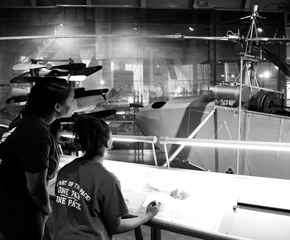A Pier Table Created to Deceive

The Background
The decorative arts collections at The Henry Ford are unique for their breadth and depth. These vast resources span more than 300 years of American history, allowing us to explore developments in the design and use of items as people’s lives, values, and tastes changed over time. The Henry Ford Museum’s furniture collection is particularly evocative of historic changes, and these objects are central to discussions of design innovations, new manufacturing methods and materials, new ways of buying and selling, and new ways of living. Consisting of more than 6,000 pieces, the furniture collection is acknowledged as one of the best in the nation.
In the late 1990s our staff reinterpreted the furniture exhibit into themes such as Showing Off, Storage, His and Hers and others that we felt would prove relevant to our audience. Studies with visitors in the years since show that although they liked the thematic approach, our visitors also wanted to see a chronological development of American furniture. In 2010 we refined the installation, now called Fully Furnished, including a timeline of American furniture, arranged through broad thematic sweeps. Called In the Latest Fashion— the chronology is divided into loose historical periods, such as Fashion for a New Nation, for the early nineteenth century or Embracing Gentility for the mid-eighteenth century—the display takes visitors on a journey through the entire span of American furniture history. Should a visitor wish to delve into a particular history or style, information is available on the text panels. Because it provides a panorama of American furniture, we selected many stellar examples from the collection to share with the public.
The Catalyst
On August 11, 2014 the Detroit metropolitan area was hit with unrelenting rain. Over 6" fell, most of it in the evening hours. The rain caused a backup of the drainage pumps on Henry Ford Museum’s rooftop. The resulting cascade of water penetrated into the museum affecting several collections. The hardest hit area was Fully Furnished, specifically artifacts, exhibition platforms, and signage. In the Latest Fashion suffered the most. The extent of damage ranged from stained fabrics to blanched original finishes and delaminated veneers to waterlogged exhibit mounts and signage.
The Pier Table
One of the most significantly damaged pieces was a Pier Table, long attributed to the workshop of New York cabinetmaker Charles-Honore Lannuier (1779–1819). Lannuier was an immigrant craftsman, who brought the latest French styles to New York in the first decade of the 19th century. His major competitor was Duncan Phyfe, (1768-1854) an immigrant from Scotland whose distinctive looking turn of the 19th century furniture was so widely imitated that many refer to his name as a style.

Immediately after the flood, the damaged objects were evaluated by the museum’s conservators. The Pier Table’s marble top prevented significant water damage, although the legs were blanched (bleached-out). Furniture conservator Mark Gervasi examined the table in great detail. Eventually, he disassembled the piece to determine the level of internal damage. What he found surprised us all. When he examined the feet he discovered they were joined with dowels, a technique not used before the late 19th century.

With closer investigation of the interior, we discovered a glaring absence of any tool marks:

The mirror on the lower section is also modern:

The underside of the marble top provided a final piece to the puzzle. Chisel marks do not match the top of our table – indicating that the marble was reused from another piece.

When considered together, these elements lead to the conclusion that the table was made sometime in the early 20th century. Most troubling is that the table was produced to deceive – the screws and brasses (the decorative metal elements) date to the early 19th century when an authentic Pier Table would have been fabricated.
While the events of August 11, 2014 were devastating, they led us to examine and expose an object that had passed as authentic since its arrival in the early 1960s. This gives truth to the old cliché that “every cloud has a silver lining.”
Charles Sable is Curator of Decorative Arts at The Henry Ford.
Henry Ford Museum, decorative arts, collections care, furnishings, by Charles Sable


Facebook Comments